Penyelidikan
Bioteknologi dan Nanoteknologi
Scope of Research
- Development and promotion of genetic engineering technology to improve the quality and productivity of crops and their yields.
- Development of diagnostic and biosensor technology for activities involving the process of monitoring contaminants in food and agricultural products.
- Development of nanotechnology for improve contamination, pest and diseases management, increased quality and yield of agricultural produces.
Expertise
- Agri-Omik & Bioinformatics (BN1)
- Bioinformatics
- Molecular Biology
- Genomics
- Genetic engineering
- Metabolomics
- Molecular markers
- Gene expression
- Gene silencing
- Proteomics
- Protein profile
- Plant culture cells
- Plant culture tissue
- DNA -based probe technology
- Recombinant technology
- Plant transformation
- Transcriptomics
- Biodiagnostic-Biosensor (BN2)
- Biodiagnostics
- Biochemistry
- Biosensor
- Immunology
- Microbial immunosensors
- Nanotechnology
- Optical sensor
- Immobilization technology
- Internet of Things (IoT)
- Lateral flow technology
- Agri-Nanotechnology (BN3)
- Pest and diseases management
- Development of nano-fungicide formulation to control fungus
- Devolopment of Nano-bactericide for paddy seed treatment
- Development of nano-carrier as biocontrol agent to control insect
- Nanomaterial synthesis
- Improving agricultural produces quality and yield
- Development of nano fertilizer for premium crop (rock melon)
- Pest and diseases management
Technology
- Improving crop quality;
- Extension of life span of Exotic papayas
- Prolongation of the fresh period of orchid flowers
- Modify the skin colour of Balinese lemons.
- Produce plants that are resistant to disease;
- Produce Exotic papaya breeds resistant to `Papaya Ring Spot Virus' (PRSV).
- Produces chillies resistant to Cucumber Mosaic Virus (CMV)
- Produce varieties of passion fruit resistant to virus (Passion fruit Mosaic Virus, PVMV)
- Produces pineapple resistant to ‘Black heart’ disease.
- Produce rice varieties resistant to red rice disease and sheath blight.
- Exploration of the fields of genomics and bioinformatics in the search for new genes;
- Isolation of pineapple fruit promoter genes.
- Genes associated with increased yield from the wild rice species O. rufipogon.
- Antibiotic Sensor for Poultry Industry

MARDI NANOSENS ANTIBIOTIC is a biosensor package technology to detect five types of antibiotics in poultry produces- tetracycline, vancomycin, streptomycin, nitrofuran and chloramphenicol. The developed biosensor system consists of sensor strips modified with polyclonal antibodies against the antibiotics and a portable biosensor reader. This offered technology can be used as antibiotic residues screening alternative and as a solution to the laborious conventional methods that are time consuming, expensive, requires tedious sample preparation and trained personnel. The MARDI NANOSENS ANTIBIOTIC is sensitive and is able to give rapid antibiotic detection for quantitative determination of antibiotic residues in on-site. This technology have unique features such as simple strip design for sample application, digital output in ppb, low range antibiotic detection (0-250 ppb), antibiotic analysis with high recovery (>90%) and high sensitivity (LOD = 50 ppb). - Rapid Nano Detection of Harmful Aquatic Algal Blooms
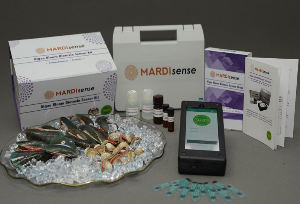
Harmful algal blooms (HABs) occurrence is increasing worldwide and becoming a significant threat to fisheries, aquaculture industries, tourism, public health and economies. Massive blooms can cause human food poisoning by accumulating of algal-origin toxins in filter-feeding shellfish. Currently there is no rapid detection for the detection of HABs that will facilitate as early warning systems in the coastal areas. Conventional methods are by means of instrumentation and mouse bioassay which are tedious, lengthy and only can be performed in the lab. With regard to this, and also concerning the affected fishery industry, economy and public health; a rapid, simple and inexpensive biosensor system for early warning system of red-tide phenomena in marine ecosystem has been developed. This biosensor consists of disposable sensor strip and portable reader for a simplified immunoassay techniques for HABs and biotoxin (saxitoxin) detection that can be performed on-sites e.g. coastal areas and markets. The reader gives a direct digital read-out of algae and bio-toxin level based on reduction current of antibody-antigen and enzyme substrate reaction. The application of this technology can be used by monitoring/regulatory agencies and will benefit to the fishery and seafood industry before any massive economy losses due to the HABs occurred. - FlocTest TM: Rapid diagnostic kit for the detection of BLB, BLS and Blast in rice
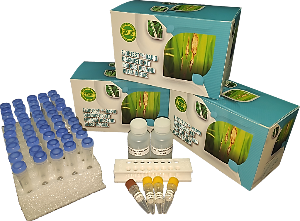
FlocTest detection kit able to detect the pathogens rapidly within 30 min. Since the technology does not involve sophisticated equipment, it can easily bring to the field and perform on-site detection. FlocTest is a combination of LAMP and flocculation assay. LAMP is an isothermal nucleic acid amplification technique which offers various advantages in diagnostic researches. It has been widely used due to its high sensitivity, specificity, quickness and cost effectiveness. The major advantage of LAMP is it can be carried out at a low constant temperature with short reaction time. This makes it perfect technique for plant pathogens detection especially for on-site applications. Besides, it has very high amplification efficiency to generate large amounts of amplicon with low amount of DNA template. Furthermore, this method is relatively cost effective as it only requires simple equipment such as mini incubator to perform the assay. To make it a naked eye detection method, we incorporated LAMP with flocculation assay where the successfully amplified long DNA in positive samples able the flocculate the particles and shift the solution color from brown to transparent which makes this phenomenon ideal for binary yes/no applications. Validation studies have been performed and the results show that the performance of FlocTest is comparable with PCR. The kit manages to detect the pathogen as fast as Day-1 after infection. We believed with this highly sensitive and specific detection kit, early detection of BLB, BLS and Blast in disease management aspect can be achieved. - Enzyme-Based Detection Kit for Malachite Green Detection in Aquaculture Industry
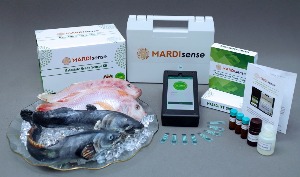
Malachite Green (MG) has been extensively used in the aquaculture industry worldwide as anti-fungal agent. MG and its derivative, Leuco-Malachite Green (LMG) may persist in the tissues of exposed fish for several months and are found to be carcinogenic, genotoxic, mutagenic and teratogenic. For that reason, MG has never been registered as veterinary drug and its administration is not allowed in the EU and US FDA. Nevertheless, MG is still widely and blatantly used illegally in fish farming due to the low cost, easy availability and high efficacy. The biosensor for total Malachite Green (MG) and Leuco-Malachite Green (LMG) detection was adapted from direct enzyme-substrate inhibition format on carbon electrode and able to detect MG/LMG as low as 0.25 ppb within 5 minutes. The developed MG biosensor showed significant sample recovery from spiked sample with various MG and LMG concentrations (0, 50, 100, 200, 300 ppb). The developed biosensor showed significant correlation (R2=0.99) with LC-MS instrumentation technique for fish samples analysis. - Lateral Flow Immunoassay (LFIA) Test Strip for Multi-Detection of Foodborne Pathogens
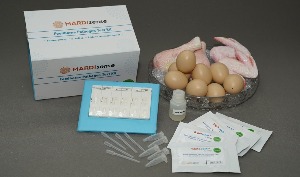
Food contamination is considered as a global burden disease since the numbers of the affected human is substantial over the years. A contaminated food may contain one or more than one type of foodborne pathogen. Common foodborne pathogens are Salmonella sp., Escherichia coli and Listeria monocytogenes. It is very crucial to detect the type of pathogens that caused the food contamination so that the patient could be treated accordingly and could include, but not limited to help the relevant parties/authorities to gather surveillance data, e.g. association of a food with a particular type of foodborne pathogen which will be helpful in the risk analysis for future prediction or in outbreak management.
Conventional culture-based method, ELISA or singleplex PCR could only detect one type of bacteria at one time. In order to detect the foodborne bacteria, all these methods need different test for each different microorganism. Although these methods have been used in the food industries, major disadvantages are tedious assay procedure and extended analysis time. Thus, rapid diagnostic tests are needed so that the foodborne pathogens could be detected in shorter time. The present invention relates to a foodborne pathogen detector incorporated with multiple test lines and a control line to provide multiple foodborne pathogens detection simultaneously. Advantageously, the present invention only takes shorter time to analyse any sample, does not involve expensive equipment, able to generate multi-detection simultaneously, does not require skilled operator to operate the device and cost-effective. - AgroZIDE™: A nano-fungicide formulation to control the growth of Aspergillus flavus in grain corn storage
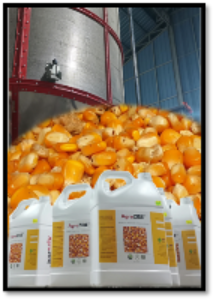
Grain corn (Zea mays L) is recognised worldwide as a major energy feed ingredient in the diets of poultry due to a combination of desirable nutritional values. To maintain the good quality and safety of grain corn, post-harvest management of the drying process plays a major role. However, exposure to moist and humid conditions during storage and the presence of broken kernels will cause the absorption of water, encouraging fungal growth such as Aspergillus flavus, a common fungal species in grain corn. A. flavus produces the mycotoxin Aflatoxin B1 (AFB1), a hepatotoxic, teratogenic and immunosuppressive to humans and animals. AgroZIDE™, a new effective nano-fungicide containing natural ingredients to control the growth of A. flavus in stored grain corn is an excellent alternative to the use of toxic chemical fungicides. AgroZIDE™ is a nano-emulsion based formulation that consists of water, cinnamon essential oil, surfactant and co-surfactant. The size of the nano-fungicide droplet ranging from 120-180 nm allows an efficient penetration of cracks or broken kernels that A. flavus spore can hide and grow. AgroZIDE™ has strong growth inhibitory activity against A. flavus based on the field trial on 2 tonnes of grain corn with treated grain corn dramatically exhibiting almost no growth of the fungus measured on the PDA compared with untreated samples that resulted in 100% growth of A. flavus after 4 months of storage period. The toxicology test carried out by SIRIM Berhad, classified AgroZIDE™as a non-toxic substance according to CLASS Regulation 2013 demonstrating the safety of AgroZIDE™. It is expected with the application of AgroZIDE™, the revenue losses in the corn grain industry due to fungal contamination can be reduced by 30%. - Essential oil -based nanoemulsions for the early treatment of rice seed -borne diseases
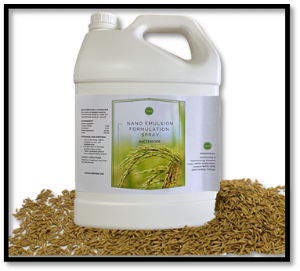
Proper pest and disease management are crucial to avoid any economic losses due to seed -borne pathogens in paddy such as bacterial leaf blight (BLB) and bacterial leaf streak diseases (BLS) caused by Xanthomonas oryzae pv oryzae (Xoo) and Xanthomonas oryzae pv oryzicola (Xoc). In severe BLB outbreaks, crop yield losses of up to 75 percent, and millions of hectares of paddy fields are infected annually. The developed nanoemulsion contain botanicals substance for the early treatment of rice seed -borne diseases to control seed -borne bacterial infections such as Xoo and Xoc. The potential of using lemon myrtle essential oil (EO) as a botanical ingredient in nanoemulsion formulation in rice seed treatment has been explored after this EO was highly effective in inhibiting the growth of Xoo and Xoc in-vitro. GC-MS analysis showed that lemon myrtle contains 84% of the citral component, which is a well-known antimicrobial compound. The particle size was estimated in the range of 27.5 ± 2.1 nm with a polydispersity index at 0.298 ± 0.018 measured with dynamic light scattering. Stability was determined using a zeta potential with a value of 38.64 ± 0.2 mV. The effect of the developed nanoemulsion on the germination rate at different immersion times showed that this formulation did not affect the germination rate compared to the control. The in-vitro results obtained showed that rice seeds treated with 1% essential oil nanoemulsion successfully inhibited the growth of Xoo and Xoc bacteria up to 95% compared to controls (untreated seeds). - Nanofertiliser emulsion formulation promotes better growth of rockmelon (Cucumis melo, L.)
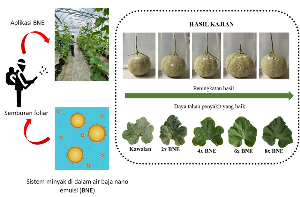
Cucumis Melo Linn, also known as Rock Melon, is a group of orange milk melons that have a crunchy and sweet fruit texture. Planting and caring for rockmelon is believed to be tough, but if done correctly, it can yield a substantial profit. The primary issue with growing this rockmelon plant is that it is prone to diseases that reduce the fruit quality and yield. In contrast to other crops, the complex care procedure, especially in the first 30 days, demands tight oversight and meticulous care because rockmelon plants are easily destroyed, damaged, or attacked by disease during this period. Predicted 50 % of the rockmelon plants planted are damaged due to suffering from mineral deficiency, disease and pest infestation. In practice, nutrient sources are depleted due to leaching, evaporation, hydrolysis, microbial degradation, and photolytic activities. Additionally, in addition to the issue of limited nutritional sources, efforts to increase rockmelon production confront a variety of hurdles today, including pest attacks, disease attacks by bacteria and viruses, and weed problems. In this uncertain weather of rain and heat, producers, particularly those cultivating this type of cucumis, find it challenging to control fungal diseases. As a result, a neem oil-based nanoemulsion fertiliser system has been effectively developed and implemented as a growth promoter and fungal disease control for rockmelon. In this study, neem oil was formulated as the oil phase of a nanoemulsion system utilised to deliver NPK-TE (Nitrogen, Phosphorus, Potassium-Trace Element) nutrients as the active component in the aqueous phase via the hydrophobic surface of the plant. Nanofertiliser was found to improve plant height, stem diameter, and chlorophyll content (p ≤0.05) at the plant growth stage compared to merely using AB fertiliser, according to the study's findings. The dry weight biomass of leaves and stems increased significantly after applying this nanofertiliser. No symptoms of powdery and downy mildew infestation were recorded with 6-8 times application frequency of the nanofertiliser. The neem oil in this nanofertiliser formulation functions as a natural fungicide, killing spores and bolstering the plant's resistance to disease attack. Fruit weight, diameter, flesh thickness, perimeter, and Brix value increased significantly (p ≤0.05) when nanofertiliser was used in 4 times applications, by 2.92 kg, 17.94 cm, 3.74 cm, 57.69 cm, and 9.4, respectively. Thus, the frequency of application of nanofertilizer fourfold could be one of the additional foliar fertiliser treatments that could be employed in the agriculture industry in the future in conjunction with AB fertigation fertiliser, thereby boosting nutrient consumption efficiency and promoting a sustainable environment. - Encapsulation of SAR-inducing recombinant proteins in chitosan nanoparticles for papaya dieback disease management

Management of papaya dieback disease, caused by Erwinia mallotivora (EM), continue to be a challenge due to scarce availability of treatments and the absence of resistance variety. Several recombinant protein formulations have shown the potential to increase the resistance of papaya towards the diseases, achieved by a mechanism known as Systemic Acquired Resistance or SAR. In order to lower the treatment cost, there is a need to create a more effective and sustainable delivery system for the SAR formulation. Nanoencapsulation of the recombinant proteins in a carrier matrix is envisaged to reduce the amount of protein needed to enter the plant apoplast to elicit the SAR activation function. A very good carrier candidate for controlled delivery of biomolecules is chitosan, due to its proven biocompatibility, biodegradability, non-toxicity, adsorption abilities as well as cost-effectiveness. Optimization for the preparation of chitosan nanoparticles loaded with recombinant proteins, HrpS (CNP-P(S)), HrpN (CNP-P(N)) and HrpX (CNP-P(X) has been carried out and the developed formulations of chitosan nanoparticles (CNP) and CNP-Ps were further evaluated for their efficiency in inducing the defence response of papaya plants by seed priming. Plant samples were collected before and after inoculation with EM to investigate the expression of selected defence-related genes by semi-quantitative RT-PCR. It was found that NPR, Osmotin, peroxidase and PR1b genes expression was relatively higher in papaya sprayed with CNP-P solutions compared to papaya plants that were sprayed with CNP or protein solution. This approach may lead to a potential cost-effective protein formulation strategy against papaya dieback disease.
Publications
-
Masniza Sairi, Khairul Anuar Shafie, Ahmad Syazwan Ismail, Nur Azura Mohd Said, Noor Azlina Masdor, Nur Humaira Md Salleh, Ten Seng Teik, Siti Noraini Bunawan, Mohd Afendy Abdul Talib, Nur Sulastri Jaffar, and Izyani Raship. 2021. Electrochemical Impedimetric Biosensor Based on Silicon-On-Insulator Nanogap for the Detection of Banana Blood Disease Bacterium. Malaysian Journal of Analytical Sciences, 25(2): 1-8
-
Nurul Azurin Badruzaman, Mohd Azraie Mohd Azmi, and Nur Azura Mohd Said. 2020. Electrochemical Immunosensor Based on Highly Sensitive Amino Functionalized Graphene Nanoplatelets-Modified Screen Printed Carbon Electrode. Key Engineering Materials, 833: 171-175 https://doi.org/10.4028/www.scientific.net/KEM.833.171
-
Nur Azura Mohd Said, Norliza Abu Bakar and Lau Han Yih. 2020. Label-free Detection of Erwinia mallotivora DNA for Papaya Dieback Disease using Electrochemical Impedance Spectroscopy Approach. ASM Sc. J., 13, Special Issue 4, 2020 for NCAFM2018, page 1-8
-
Norhafniza Awaludin, Jaafar Abdullah, Faridah Salam, Kogeethavani Ramachandran, Nor Azah Yusof and Helmi Wasoh. 2020. Fluorescence-based Immunoassay for the Detection of Xanthomonas Oryzae Pv. Oryzae in Rice Leaf. Analytical Biochemistry. 610: 113876. https://doi.org/10.1016/j.ab.2020.113876
-
Suria Mohd Saad, Jaafar Abdullah, Suraya Abdul Rashid, Yap Wing Fen, Faridah Salam and Lau Han Yih. 2020. A Carbon Dots Based Fluorescence Sensing for the Determination of Escherichia coli O157:H7. Measurement 160: 107845. https://doi.org/10.1016/j.measurement.2020.107845
-
Ekta Rani, Siti Akhtar Mohshim, Nor Hidayat Yusof, Muhammad Zamharir Ahmad, Royston Goodacre, Shahrul Ainliah Alang Ahmad and Lu Shin Wong. 2020. Sensitive and selective detection of DNA fragments associated with Ganoderma boninense by DNA-nanoparticle conjugate hybridisation. Journal of Materials Science 55:14965–14979 https://doi.org/10.1007/s10853-020-05058-8
-
Nurul hidayah Husin, Nur Azura Mohd Said, Norhafniza Awaludin, Rafidah Abd Rahman, Ramachandran, K. and Faridah Salam. 2020. Development of Electrochemical Biosensor for the Detection of Xanthomonas oryzae pv. oryzae in Bacterial Leaf Blight Disease and its Cross-reactivity Study. Transactions of the Malaysian Society of Plant Physiology Volume 27 (eISSN 2600-9595), p.247-250
-
Rafidah Abd Rahman, Hazana Razali, Nur Azura Mohd Said, Noor Azlina Masdor, and Faridah Salam. 2020. Determination of Immunosensor Parameters for a Sensitive and Rapid Detection of Xanthomonas oryzae pv. Oryzae. Transactions of the Malaysian Society of Plant Physiology Volume 27 (eISSN 2600-9595), p.228-232
-
Suria Mohd Saad. 2020. A Fluorometric Gene Assay for Determination of Escherichia coli O157:H7 Using Graphene Quantum Dots and Carbon Dots With Gold and Silver Nanoparticles. Thesis PhD, Universiti Putra Malaysia.
-
Hazana Razali, Nur Azura Mohd Said and Faridah Salam. 2019. Immunosensor Development for the Detection of Xanthomonas oryzae pv. oryzicola in Rice Bacterial Leaf Streak. eISSN 2600-9595 Trans. Malaysian Soc. Plant Physiol. 26: 315-319
-
Suria Mohd Saad, Jaafar Abdullah, Suraya Abdul Rashid, Yap Wing Fen, Faridah Salam and Lau Han Yih. 2019. A fluorescence quenching based gene assay for Escherichia coli O157:H7 using graphene quantum dots and gold nanoparticles. Microchimica acta 186:804 https://doi.org/10.1007/s00604-019-3913-8
-
Ekta Rani, Siti Akhtar Mohshim, Muhammad Zamharir Ahmad, Royston Goodacre, Shahrul Ainliah Alang Ahmad, and Lu Shin Wong. 2019. Polymer Pen Lithography-Fabricated DNA Arrays for Highly Sensitive and Selective Detection of Unamplified Ganoderma Boninense DNA. Polymers 11(3), 561: 1-12 https://doi.org/10.3390/polym11030561
-
Suhaili Sabdin, Mohd Azraie Mohd Azmi, Nurul Azurin Badruzaman, Fatihatul Zuriati Makmon, Azman Abd Aziz, and Nur Azura Mohd Said. 2019. Effect of APTES Percentage towards Reduced Graphene Oxide Screen Printed Electrode Surface for Biosensor Application. Materials Today: Proceedings 19: 1183–1188 https://doi.org/10.1016/j.matpr.2019.11.121
-
M.N.A Uda, C.M. Hasfalina, A. Samsuzana, S. Faridah, Subash C.B. Gopinath, N.A. Parmin, U. Hashim, and Mazidah Mat. 2019. A Disposable Biosensor Based on Antibody-Antigen Interaction for Tungro Disease Detection. Nanobiosensors for Biomolecular Targeting : 147-164 https://doi.org/10.1016/B978-0-12-813900-4.00006-3
-
Lau Han Yih, Faridah Salam, and Sohana Romeli. 2019. Sensitive detection of Pyricularia oryzae by Loop Mediated Isothermal Amplification (LAMP). Trans. Malaysian Soc. Plant Physiol vol 26
-
Nur Azura Mohd Said, Hazana Razali, Rafidah Abd Rahman, Noor Azlina Masdor, Mohammad Rejab Ismail and Faridah Salam. 2019. Immunosensor development for the detection of Xanthomonas oryzae pv. oryzicola in rice bacterial leaf streak. Trans. Malaysian Soc. Plant Physiol. Vol 26
-
Adlin Azlina Abdul Kadir, Noriha Amin and Erna Mutiara Masdek. 2019. Development of Early Detection of Dieback Disease (Erwinia mallotivora) by using Lateral Flow Immunoassay (LFIA) Technique. Trans. Malaysian Soc. Plant Physiol. Vol 26
-
Masdor, N. A., Padrilah, S. N., Rani, R. M., Abd Karim, M. S., Bakar, M. Z., & Ismail, A. S. (2022). The Effect of Temperature and Incubation Period on the Size and Polydispersity Index of the Nano-Emulsion Containing Essential Oil from Cinnamomum zeylanicum. In Materials Science Forum (Vol. 1055, pp. 105-109). Trans Tech Publications Ltd.
-
Azmi, A., Lau, K. S., Chin, S. X., Zakaria, S., & Chia, C. H. (2022). Regenerated cellulose membrane incorporating photocatalytic zinc oxide as a bifunctional membrane for decoloration of methylene blue. Polymers for Advanced Technologies, 33(3), 843-850.
-
Azmi, A., Lau, K. S., Chin, S. X., Khiew, P. S., Zakaria, S., & Chia, C. H. (2021). Zinc oxide-filled polyvinyl alcohol–cellulose nanofibril aerogel nanocomposites for catalytic decomposition of an organic dye in aqueous solution. Cellulose, 28(4), 2241-2253.
-
Abdul Kahar, A. (2021). Effect of drying on the kinetics, stability of active ingredients and non-destructive testing of Backhousia citriodora (lemon myrtle) dehydrated leaves (Doctoral dissertation, University of Nottingham Malaysia).
-
Masdor, N. A., Talib, A., Salam, F., Mohd Said, N. A., & Ghazali, M. S. (2018). Sensitivity and Specificity Test of the Polyclonal Antibody Produced against Xanthomonas oryzae. Plant Productivity and Environmental Conservation, 239.
-
Noor Azlina, M., Faridah, S., Khalisanni, K., Nur Sabrina, W., Mohd Shahrin, G., Muhamad Shafiq, A. K., ... & Siti Norsuha, M. (2019). Screening for antimicrobial activity of essential oils against Xanthomonas oryzae pv. oryzicola. In 28th Malaysian Society of Plant Physiology Conference (MSPPC 2018), Challenges and strategies for plant productivity and resilience, Kelantan, Malaysia, 28-30 August 2018 (pp. 287-290). Malaysian Society of Plant Physiology (MSPP).
-
Rafidah, A. R., Norhafniza, A., Faridah, S., & Asfaliza, R. (2018). Bacteria leaf blight disease of rice: Characterisation of pathogen and polyclonal antibody production of Xanthomonas oryzae pv. oryzae. Transactions of the Malaysian Society of Plant Physiology, 25, 247-252.
-
Khalisanni, K., Muhammad Najib, O. G., Noorhapizah, N., & Hartinee, A. Nanofertilizer-nitrogen, Phosphorus, and Potassium (NPK) Uptake by Carica papaya var. Sekaki Seedlings. Emerging Trends of Plant Physiology in Changing Environment, 189.
-
Khalisanni K, et al (2020) Nanocrystalline Cellulose for Food Packaging in Tumirah K, Latifah J, Mohd KAU, Lee SH (Eds), Nanotechnology: Potential Applications in Forest Products Sector, pp. 77-79, Kuala Lumpur, Malaysia (ISBN 978-967-2149-85-9)
-
Khalid, K., Tan, X., Mohd Zaid, H. F., Tao, Y., Lye Chew, C., Chu, D. T., Ho, Y.C., Lam, M.K., Lim, J.W. & Chin Wei, L. (2020). Advanced in developmental organic and inorganic nanomaterial: A review. Bioengineered, 11(1), 328-355.
-
Hazalina, Z., Norhayu, A., Dzolkhifli, O., Siti Izera, I., & Noor Azlina, M. (2021) Lemon Myrtle Essential Oil as a Potential Botanical Pesticide Against Bacterial Leaf Blight Disease (Xanthomonas oryzae pv. oryzae) in Paddy. Emerging Trends of Plant Physiology in Changing Environment, 135-141
-
Hazalina, Z., Norhayu, A., Dzolkhifli, O., Siti Izera, I. and Noor Azlina, M. (2020). Minyak pati sebagai kawalan botani penyakit hawar daun bakteria (BLB). Abstrak dalam buku Program Kolokium Perlindungan Tanaman 2020, ms: 80. Ibu Pejabat MARDI 25-26 Ogos 2020.
-
Wahid, N.S., Mohd Nor, N.S., Bashirah, R.A., Abu Bakar, N., Masdor, N.A. and Masaruddin, M.S. (2020). Encapsulation Efficiency of SAR-inducing Recombinant Protein in Chitosan Nanoparticles at Different Chitosan:TPP:Protein Ratio. Transactions of the Malaysian Society of Plant Physiology, 27, 223-227
Contact
PENGARAH
Pusat Penyelidikan Bioteknologi & Nanoteknologi (BN)
Ibu Pejabat MARDI
Telefon : 03-8953 6090
No.Faks : 03-8953 6100
 Bahasa Melayu
Bahasa Melayu  English
English 